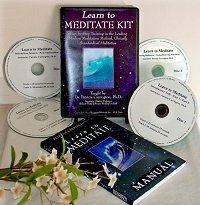Dr. Patricia Carrington's award winning meditation technique CSM (Clinically Standardized Meditation) is a clinically sensitive meditation method developed by the Medical Department of New York Telephone Company and used by numerous medical institutions, organizations, and individuals worldwide. For information click here.
Problems in the Use of Meditation
Is it Possible that Some People Don’t Need Meditation?
Patricia Carrington, Ph.D.
Author of “The Book of Meditation”
Meditation is not a panacea. Not everyone wants to learn it and not everyone who learns it benefits from it. Some people who do benefit from it discontinue the practice. It is also possible that other people do not need meditation because their life-style already supplies them with something equally satisfying.
Dr Mihaly Csikszentmihalyi and his research team at the University of Chicago have a fascinating theory of pleasure based on their study of people involved in deeply gratifying activities.1 This concept, which they call ‘flow’, has many things in common with the meditative mood.
According to the Chicago group, flow is present when the person is so totally involved in whatever he is doing that there is no time to get bored or to worry about what may or may not happen. They studied this holistic sensation that people feel when they act with total involvement – as flow – in structured interviews conducted with a large number of individuals involved in a wide variety of activities.
Careful analysis of these interviews revealed that games are obvious flow experiences and play is the most complete form of all. Yet playing a game is no guarantee that one is experiencing flow – it is the ingredients of the experience that count. If the person is totally engrossed, ‘lost’ in the game, then she may enter flow.
Flow is often present in creativity. People as diverse as composers and dancers, rock climbers and chess players, surgeons involved in medical research and mathematicians working in the frontiers of their fields, all experience flow. When they do, it is usually so enjoyable they are willing to forsake many other things for it, including money, fame or comfort. In a certain sense, flow is the essential joy of living, beside which all other considerations are insignificant.
The Chicago group was the first to investigate this human experience with the methods of science and to identify what they believe to be its main elements. They describe these as follows:
Flow is a state of total absorption. As an outstanding chess player describes it:
The game is a struggle, and the concentration is like breathing – you never think of it. The roof can fall in and, if it missed you, you would be unaware of it.2
Flow involves centering one’s attention on a limited stimulus field – with all else shut out. A professor of science who climbs rocks says: When I start on a climb, it is as if my memory input has been cut off. All I can remember is the last thirty seconds, and all I can think of ahead, is the next five minutes.3
Flow involves a kind of self-forgetfulness. This does not mean that the person in flow loses touch with his or her own physical reality or sense of existence, they may be more exquisitely aware of them than ever. What is lost is the artificial ‘self construct’, the awareness of social roles and role-playing. The sense that, ‘I am such and such a person, with such and such a name and status who is taking action’, fades, and a far more fundamental sense of self takes over. In flow there is no social ‘me’, no learned awareness of ‘self’, no ego-sense, to stand as a screen between each person and total experience. An outstanding composer says:
You yourself are in an ecstatic state to such a point that you feel as though you almost don’t exist. . . . I just sit there watching . . . in a state of awe and wonderment. And it (the music) just flows out by itself.4
A chess player says:
Time passes a hundred times faster. In this sense, it resembles the dream states. A whole story can unfold in seconds. . . . Your body is nonexistent – but actually your heart pumps like mad to supply the brain.5
In flow the person is in control of his actions and his environment – he or she can cope. A dancer says:
A strong relaxation, and calmness comes over me. I have no worries of failure. . . . I want to expand, hug the world. I feel enormous power to effect something of grace and beauty.6
For flow to occur, the demands of the situation must be clear-cut, predictable, and not contradictory. In flow the person must be able to know at any moment where she or he is with the activity. Rules of a game, the specific training in certain skills or rituals, which are to be followed, make flow possible. They allow people participating in it to evaluate how they are proceeding without having to think about it at all, without needing to break the absorption. A basketball player says:
I play my best game almost by accident. . . . If I’m having a super game I can’t tell [whether I’m playing well] until after the game. . . . Guys make fun of me because I can lose track of the score.7
Flow involves no goals or rewards external to itself. A young poet who is a seasoned rock climber says: You get to the top of a rock glad it’s over but really wish it would go forever. . . . The justification of climbing is climbing, like the justification of poetry is writing; you don’t conquer anything except things in yourself. . . . You are a flow. The purpose of the flow is to keep on flowing.8
By this definition, many meditation sessions are also a form of flow. When the person is deeply into meditation, thought follows upon thought according to its own inner logic and needs no conscious intervention by the meditator; attention is strictly limited to only a few basic matters; activity is totally absorbing. The meditator is also in complete control of his actions and is protected from decisions by the ritual involved. During meditation there is little distinction between self and environment, between stimulus and response, between past, present and future – attention is riveted on the intensity of the moment.
What does the concept of flow teach us about the need to meditate? Will a skier who regularly enters a state of flow in her downhill glides, experiencing ice and wind in perfect balance and existing in moments outside of time, still feel like meditating later that same day if she is a regular meditator? Is the need for flow ever-present, or does it wax and wane? Is there a need to balance one type of flow with another? Do people seek to alternate active flow experiences with those which are passive and receptive in nature – the age-old need to experience both aspects of life: repose and tension, the feminine and the masculine, Yin and Yang?
These are crucial questions which must be answered if we are to discover whether other activities can supply the same ingredients as meditation and if they can make meditation superfluous for certain people – or perhaps for all people at certain times. It is at least plausible that some people do not need to meditate because they live with a pervasive sense of harmony in their lives. Who these people might be, and why they should feel this way, however, is as yet unknown.
We do know, though, that certain people whose lives are apparently unfulfilling, people who are tense and driven in their behavior, are also frequently disinterested in learning meditation. Such people will not sign up to learn it even when meditation is offered free as part of a curriculum, or at a guidance clinic. They remain disinterested even if their family or friends are enthusiastic about the practice. It looks as though such people are actively avoiding learning it.
Although no research has been done of tense people who avoid meditation, some clinical reports on patients who have persistently resisted suggestions that they learn to meditate give us some clues about the reasons for such resistance.
1. M. Csikszentmihalyi, Flow: The Psychology of Optimal Experience (New York: HarperCollins, 1991).
2. M. Csikszentmihalyi, Beyond Boredom and Anxiety (San Francisco: Jossey-Bass, 1975).
3. Ibid, p. 39.
4. Ibid, p. 40.
5. Ibid, p. 44.
6. Ibid.
7. Ibid.
8. Ibid, p. 47.

